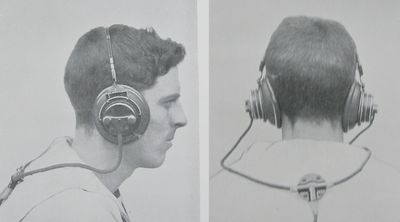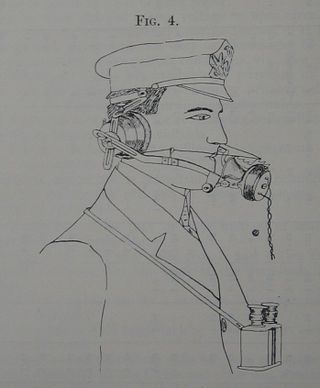Telaupad

In 1912, it was decided that these were to become the model for all future supply.[1] It was proudly noted that springs helped maintain a tight fit with rubber rings helping isolate sound.
Telaupad is the contemporary British term for headphones used in a variety of shipboard applications, often in Fire Control tasks where the operator had to keep his hands free and be attentive to a remote source of information and command.
Form Factor

This design was found to weigh 1.5 pounds and to work pretty well by lashing a Patt. 520 transmitter to what might have been the current model of telaupad.[2] It was noted that binoculars could be freely used aloft with these headsets.
Telaupads where essentially large headphones, often with a good effort made at isolating the wearer from external sound.
In time, some telaupad users were also given microphones so they had a complete hands-free means of communicating bidirectionally.
The earliest testing had been done in Dreadnought and Prince of Wales and reproduced in Revenge.[3]
Application
Sightsetters were ideal candidates for wearing telaupads, particularly in the days before F.T.P. sights came into service, or in smaller ships or ships whose secondary batteries could not receive timely outfits of specialised hardware. It required very little engineering and fuss to wire up a ship so a telaupad could be tethered fairly near each gun.
By 1908, 144 ships had been equipped with telaupads for use at guns and searchlights. Despite its general usefulness, it was regarded as especially applicable to night use.[4]
In 1911, successful tests of equipment prototypes from Vernon for control of light Q.F. guns "proved satisfactory in every way, and no breakdowns or failures have been experienced, and it is therefore recommended for adoption." This report caused the issuance of orders in November to proceed with the pattern of telaupad and headpiece that had fared so well. It is likely that model shown in the photo above.[5]
In 1912, a new pattern of receiver (the earphone) was to be made available, the Pattern 555. It featured naval brass for the case and a cable clamp that removed strain from the terminals.[6]
In late 1913, telaupads for use at light Q.F. guns and for searchlight operators were replaced by use of flexible voice piping and the telaupads returned to store. The telaupads presently used on guns of 4-in to 7.5-in continued.[7]
Telaupads were used during the Admiralty air defence of London as the communication gear for the searchlight operators connected (by telephone) to the Admiralty Arch central gun control emplacement. Telaupads had by October 1914 replaced the telephones used by the gun operators themselves.[8]
See Also
Footnotes
- ↑ Annual Report of the Torpedo School, 1912. p. 78, Plates 42-3.
- ↑ Annual Report of the Torpedo School, 1910. p. 152, Fig. 4.
- ↑ Fire Control, 1908, p. 8.
- ↑ Fire Control, 1908. p. 8.
- ↑ Annual Report of the Torpedo School, 1911. p. 95.
- ↑ Annual Report of the Torpedo School, 1912. p. 79.
- ↑ Admiralty Weekly Order No. 667 of 21 Nov 1913.
- ↑ Roskill Document #52 Extracts from 'Report on the Subject of the Defence of London against Aerial Attack', by Captain Murray F. Sueter, Director, Air Department, Admiralty, dated 16 October 1914 (Cab.37/121/125), p. 174
Bibliography
- H.M.S. Vernon. Annual Report of the Torpedo School, 1910, with Appendix (Wireless Telegraphy). Copy 436 at The National Archives. ADM 189/30.
- H.M.S. Vernon. Annual Report of the Torpedo School, 1911, with Appendix (Wireless Telegraphy). Copy 15 at The National Archives. ADM 189/31.
- H.M.S. Vernon. Annual Report of the Torpedo School, 1912, with Appendix (Wireless Telegraphy). Copy 17 at The National Archives. ADM 189/32.